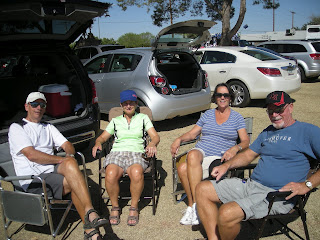
On March 12th, we took in a Cactus League baseball game between the Chicago Cubs and the Cincinnati Reds. We met up with Dave and Lise, our Recreationland neighbors. It was a picture perfect day, with an 80 degree temperature, and bright sunshine. The game was being held in Hohokam Stadium in Mesa. The final score was Cubs 8, Reds 6.


Hohokam Park - Ancient History
Hohokam Park (pronounced “HO-HO-COM”) takes its name from some of the earliest residents of the Valley of the Sun: the Hohokam Indians, who occupied this region from the year AD 1 until the mid-1400s. The name “Hohokam” is a derivative from a Pima Indian word for “all used up” or “those who are gone.”



The Hohokam were one of the world’s most advanced prehistoric civilizations, and were able to flourish in central Arizona’s desert region for more than a thousand years by developing a sophisticated system of irrigation canals, totaling more than 125 miles. These canals were so effective that much of today’s canal system follows along the same pattern engineered by the Hohokam centuries before.




Hohokam Park is located just a few blocks east of the Mesa Grande Ruin, at the corner of Date and 10th Street, believed to contain the remnants of one of the key Hohokam temples and gathering structures. This site was purchased by the City of Mesa in the late 1980s for future preservation and study.
The reasons for the sudden disappearance of the Hohokam Indians around 1450 are still subject to debate, although many theories (drought, disease, warfare with neighboring tribes) have been proposed. Many artifacts from the Hohokam civilization, as well as replicas of Hohokam dwellings, are on permanent display at the City of Mesa’s museum of history, the Arizona Museum of Natural History.
Baseball in Mesa - an abbreviated history
Baseball has been a part of Mesa since the very beginning. In fact, back in 1876, just as Albert Spalding and William Hulbert were organizing the National League, a party of 84 men, women and children gathered in St. George, Utah, to embark on a 49-day journey to the south to establish the first settlement in an area just a half-dozen miles up the road from where the stadium now sits.
The success of local amateur teams like the Mesa Jewels led the community to build their first permanent baseball field in 1921, at the corner of 2nd Street and Sirrine. With the development of the nearby Rendezvous Hall, for social events, and Rendezvous Pool, the ballpark gradually became known as “Rendezvous Park.”
The Chicago Cubs first expressed interest in training in Mesa as early as 1942, when a contingent of Cubs officials met with City officials to evaluate the ballpark and lodging facilities. But it was not until 1952 that the final decision was made for the Chicago Cubs to use Mesa as their spring training home. Six major league exhibition games were played in Mesa that season, against the Cleveland Indians, New York Giants, Pittsburgh Pirates, and crosstown rival Chicago White Sox.
Amenities at the old Rendezvous Park were somewhat less than ideal. The clubhouse was too small to accommodate the players’ luggage; the trunks were moved outside each morning and returned to the clubhouse at the end of the day. Extra bleachers were rented to accommodate the large number of spectators, and 500 wooden chairs were acquired from Los Angeles Wrigley Field, to serve as “box seats.”
Improvements were made to Rendezvous Park over the years, with the Cubs training at the site through 1965. After a three-year absence, spring training returned to Mesa when an agreement was reached with the Oakland A’s. Mesa was Oakland’s spring training site for 10 years, including their three consecutive world championship seasons from 1972 to 1974.
Rendezvous Park finally fell victim to the wrecking ball in November 1976, replaced by the first stadium at Hohokam Park, dedicated in 1977. The A’s continued training at this new facility until 1979, at which time the Chicago Cubs relocated back to Mesa from Scottsdale. It was during the mid-1980s that the Cubs enjoyed unprecedented attendance, ranking as the Cactus League’s largest draw, and at or near the top of all major league teams in spring training admissions.
This support from area residents and winter visitors played a large role in the development of the expanded Hohokam Park in 1997. With the addition of outfield berm seating and increase of 1,000 new reserved seats, capacity of the stadium is 12,500.
No comments:
Post a Comment